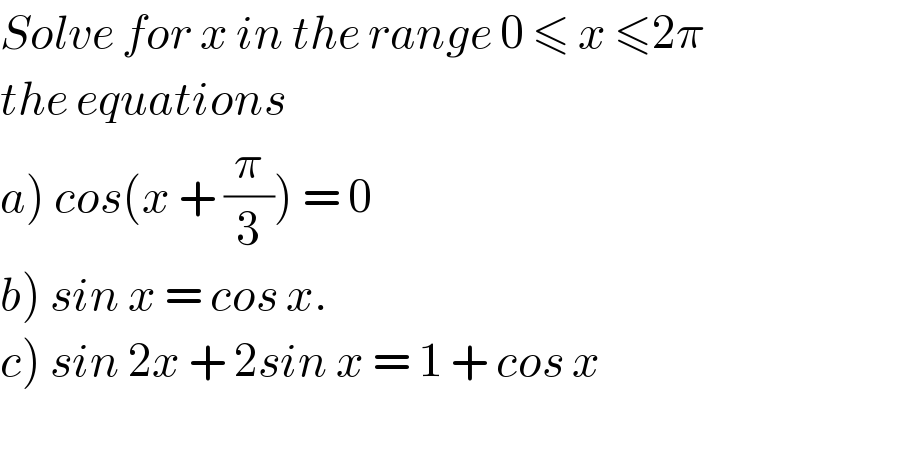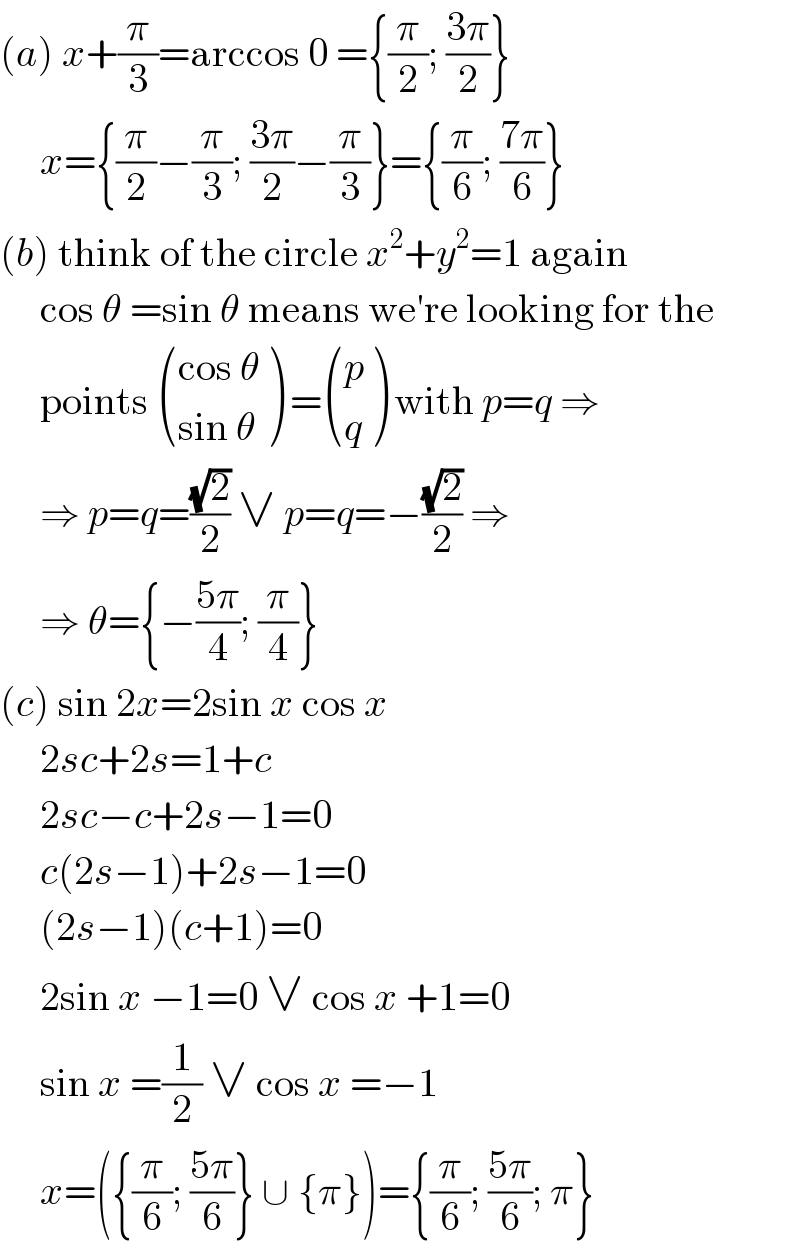Question Number 39587 by Rio Mike last updated on 08/Jul/18

$${Solve}\:{for}\:{x}\:{in}\:{the}\:{range}\:\mathrm{0}\:\leqslant\:{x}\:\leqslant\mathrm{2}\pi \\ $$$${the}\:{equations} \\ $$$$\left.{a}\right)\:{cos}\left({x}\:+\:\frac{\pi}{\mathrm{3}}\right)\:=\:\mathrm{0}\: \\ $$$$\left.{b}\right)\:{sin}\:{x}\:=\:{cos}\:{x}. \\ $$$$\left.{c}\right)\:{sin}\:\mathrm{2}{x}\:+\:\mathrm{2}{sin}\:{x}\:=\:\mathrm{1}\:+\:{cos}\:{x} \\ $$$$ \\ $$
Answered by Joel579 last updated on 08/Jul/18

$$\mathrm{cos}\:\left({x}\:+\:\frac{\pi}{\mathrm{3}}\right)\:=\:\mathrm{0} \\ $$$${x}\:+\:\frac{\pi}{\mathrm{3}}\:=\:{n}\pi\:+\:\frac{\pi}{\mathrm{2}}\:\:\:\:\left({n}\:=\:\mathrm{0},\:\mathrm{1}\right) \\ $$$${x}\:=\:\frac{\pi}{\mathrm{6}}\:\:\vee\:\:\:{x}\:=\:\frac{\mathrm{7}\pi}{\mathrm{6}} \\ $$
Answered by Joel579 last updated on 08/Jul/18

$$\mathrm{sin}\:{x}\:=\:\mathrm{cos}\:{x} \\ $$$$\mathrm{tan}\:{x}\:=\:\mathrm{1} \\ $$$${x}\:=\:{n}\pi\:+\:\frac{\pi}{\mathrm{4}}\:\:\left({n}\:=\:\mathrm{0}\right) \\ $$$${x}\:=\:\frac{\pi}{\mathrm{4}} \\ $$
Answered by Joel579 last updated on 08/Jul/18

$$\mathrm{2}\:\mathrm{sin}\:{x}\:\mathrm{cos}\:{x}\:+\:\mathrm{2sin}\:{x}\:=\:\mathrm{1}\:+\:\mathrm{cos}\:{x} \\ $$$$\mathrm{2sin}\:{x}\left(\mathrm{cos}\:{x}\:+\:\mathrm{1}\right)\:=\:\mathrm{1}\:+\:\mathrm{cos}\:{x} \\ $$$$\mathrm{2sin}\:{x}\left(\mathrm{1}\:+\:\mathrm{cos}\:{x}\right)\:−\:\left(\mathrm{1}\:+\:\mathrm{cos}\:{x}\right)\:=\:\mathrm{0} \\ $$$$\left(\mathrm{2sin}\:{x}\:−\:\mathrm{1}\right)\left(\mathrm{1}\:+\:\mathrm{cos}\:{x}\right)\:=\:\mathrm{0} \\ $$$$\mathrm{sin}\:{x}\:=\:\frac{\mathrm{1}}{\mathrm{2}}\:\:\:\:\:\rightarrow\:\:{x}\:=\:\frac{\pi}{\mathrm{6}},\:\frac{\mathrm{5}\pi}{\mathrm{6}} \\ $$$$\mathrm{cos}\:{x}\:=\:−\mathrm{1}\:\:\rightarrow\:\:{x}\:=\:\pi \\ $$
Answered by MJS last updated on 08/Jul/18

$$\left({a}\right)\:{x}+\frac{\pi}{\mathrm{3}}=\mathrm{arccos}\:\mathrm{0}\:=\left\{\frac{\pi}{\mathrm{2}};\:\frac{\mathrm{3}\pi}{\mathrm{2}}\right\} \\ $$$$\:\:\:\:\:{x}=\left\{\frac{\pi}{\mathrm{2}}−\frac{\pi}{\mathrm{3}};\:\frac{\mathrm{3}\pi}{\mathrm{2}}−\frac{\pi}{\mathrm{3}}\right\}=\left\{\frac{\pi}{\mathrm{6}};\:\frac{\mathrm{7}\pi}{\mathrm{6}}\right\} \\ $$$$\left({b}\right)\:\mathrm{think}\:\mathrm{of}\:\mathrm{the}\:\mathrm{circle}\:{x}^{\mathrm{2}} +{y}^{\mathrm{2}} =\mathrm{1}\:\mathrm{again} \\ $$$$\:\:\:\:\:\mathrm{cos}\:\theta\:=\mathrm{sin}\:\theta\:\mathrm{means}\:\mathrm{we}'\mathrm{re}\:\mathrm{looking}\:\mathrm{for}\:\mathrm{the} \\ $$$$\:\:\:\:\:\mathrm{points}\:\begin{pmatrix}{\mathrm{cos}\:\theta}\\{\mathrm{sin}\:\theta}\end{pmatrix}\:=\begin{pmatrix}{{p}}\\{{q}}\end{pmatrix}\:\mathrm{with}\:{p}={q}\:\Rightarrow \\ $$$$\:\:\:\:\:\Rightarrow\:{p}={q}=\frac{\sqrt{\mathrm{2}}}{\mathrm{2}}\:\vee\:{p}={q}=−\frac{\sqrt{\mathrm{2}}}{\mathrm{2}}\:\Rightarrow\: \\ $$$$\:\:\:\:\:\Rightarrow\:\theta=\left\{−\frac{\mathrm{5}\pi}{\mathrm{4}};\:\frac{\pi}{\mathrm{4}}\right\} \\ $$$$\left({c}\right)\:\mathrm{sin}\:\mathrm{2}{x}=\mathrm{2sin}\:{x}\:\mathrm{cos}\:{x} \\ $$$$\:\:\:\:\:\mathrm{2}{sc}+\mathrm{2}{s}=\mathrm{1}+{c} \\ $$$$\:\:\:\:\:\mathrm{2}{sc}−{c}+\mathrm{2}{s}−\mathrm{1}=\mathrm{0} \\ $$$$\:\:\:\:\:{c}\left(\mathrm{2}{s}−\mathrm{1}\right)+\mathrm{2}{s}−\mathrm{1}=\mathrm{0} \\ $$$$\:\:\:\:\:\left(\mathrm{2}{s}−\mathrm{1}\right)\left({c}+\mathrm{1}\right)=\mathrm{0} \\ $$$$\:\:\:\:\:\mathrm{2sin}\:{x}\:−\mathrm{1}=\mathrm{0}\:\vee\:\mathrm{cos}\:{x}\:+\mathrm{1}=\mathrm{0} \\ $$$$\:\:\:\:\:\mathrm{sin}\:{x}\:=\frac{\mathrm{1}}{\mathrm{2}}\:\vee\:\mathrm{cos}\:{x}\:=−\mathrm{1} \\ $$$$\:\:\:\:\:{x}=\left(\left\{\frac{\pi}{\mathrm{6}};\:\frac{\mathrm{5}\pi}{\mathrm{6}}\right\}\:\cup\:\left\{\pi\right\}\right)=\left\{\frac{\pi}{\mathrm{6}};\:\frac{\mathrm{5}\pi}{\mathrm{6}};\:\pi\right\} \\ $$
